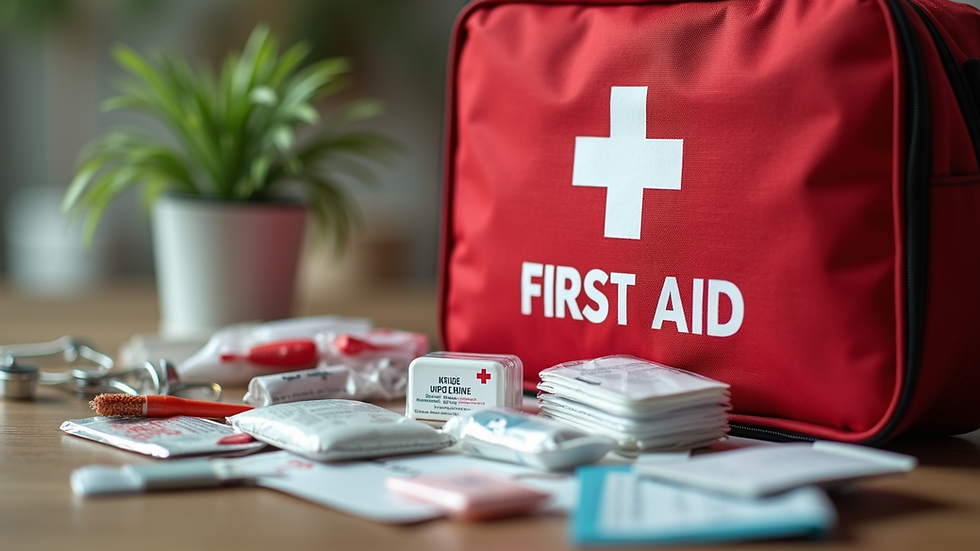Creating a Comprehensive Safety Strategy for Your Team
- Aryeh Goldberg

- Aug 4
- 4 min read
Ensuring the safety of your team is a critical responsibility that requires a well-thought-out approach. A comprehensive safety strategy not only protects employees but also enhances productivity, reduces costs related to accidents, and fosters a positive workplace culture. This article will guide you through the essential components of creating an effective safety strategy tailored to your team’s needs.
Understanding the Importance of a Safety Strategy
A safety strategy is a structured plan designed to identify, assess, and mitigate risks in the workplace. It goes beyond simple compliance with regulations and focuses on creating a proactive safety culture. When a team understands the importance of safety, they are more likely to follow protocols and contribute to a safer environment.
Key benefits of a safety strategy include:
Reducing workplace accidents and injuries
Minimising downtime caused by incidents
Lowering insurance and compensation costs
Improving employee morale and retention
Enhancing company reputation
To develop a robust safety strategy, it is essential to start with a thorough risk assessment. This involves identifying potential hazards specific to your workplace and evaluating their likelihood and impact.

Building Your Safety Strategy: Key Components
Creating a safety strategy involves several critical steps that ensure all aspects of workplace safety are covered. Here are the main components to focus on:
1. Risk Assessment and Hazard Identification
Begin by conducting a detailed risk assessment. This process should involve:
Inspecting the workplace for physical hazards such as machinery, chemicals, or uneven surfaces
Reviewing past incident reports to identify recurring issues
Consulting with employees to understand their concerns and observations
2. Developing Safety Policies and Procedures
Once risks are identified, develop clear policies and procedures to address them. These should be:
Written in simple, understandable language
Easily accessible to all employees
Regularly reviewed and updated
3. Training and Education
Effective training ensures that all team members understand safety protocols and know how to respond in emergencies. Training should be:
Tailored to specific roles and risks
Conducted regularly, including refresher sessions
Supported by practical drills and demonstrations
4. Communication and Reporting
Encourage open communication about safety concerns. Implement systems for:
Reporting hazards or near misses without fear of reprisal
Sharing safety updates and reminders
Recognising and rewarding safe behaviour
5. Monitoring and Continuous Improvement
Safety is an ongoing process. Regularly monitor the effectiveness of your strategy by:
Conducting audits and inspections
Analysing incident data
Seeking employee feedback
Adjust your strategy based on findings to continuously improve workplace safety.

What are the 7 steps of safety?
Understanding the fundamental steps to safety can help structure your strategy effectively. The seven steps typically include:
Identify Hazards - Recognise potential sources of harm in the workplace.
Assess Risks - Evaluate the likelihood and severity of harm from each hazard.
Control Risks - Implement measures to eliminate or reduce risks.
Develop Procedures - Create clear guidelines for safe work practices.
Train Employees - Educate staff on hazards and safe procedures.
Monitor and Review - Regularly check the effectiveness of controls and update as needed.
Promote Safety Culture - Encourage a workplace environment where safety is a shared responsibility.
By following these steps, you can build a safety strategy that is both comprehensive and practical.

Implementing Your Safety Strategy Effectively
Having a plan is one thing; putting it into action is another. Here are actionable recommendations to ensure your safety strategy is successfully implemented:
Assign Responsibility: Designate safety officers or committees to oversee implementation and compliance.
Engage Leadership: Ensure management actively supports and participates in safety initiatives.
Use Technology: Leverage safety management software to track incidents, training, and audits.
Encourage Participation: Involve employees in safety discussions and decision-making.
Regularly Update Training: Keep training materials current with the latest regulations and best practices.
Emergency Preparedness: Develop and practice emergency response plans tailored to your workplace.
Remember, a safety strategy is only as good as its execution. Consistent effort and commitment from all levels of the organisation are essential.
Enhancing Safety with a Plan for Safety
To further strengthen your safety approach, consider integrating professional resources such as Plan For Safety. These services offer expert guidance, training, and support tailored to workplace health and safety requirements. Partnering with specialists can help you stay compliant with regulations and adopt best practices efficiently.
By combining internal efforts with external expertise, your team will benefit from a well-rounded and effective safety strategy.
Sustaining a Culture of Safety
Creating a comprehensive safety strategy is not a one-time task but a continuous journey. To sustain a culture of safety:
Celebrate Successes: Recognise teams and individuals who contribute to safety improvements.
Maintain Open Dialogue: Keep communication channels open for ongoing feedback.
Adapt to Change: Update your strategy as new risks emerge or workplace conditions evolve.
Invest in Wellbeing: Promote overall employee health, which supports safer work habits.
A strong safety culture empowers employees to take ownership of their wellbeing and that of their colleagues, leading to a safer and more productive workplace.
By following these guidelines and committing to continuous improvement, you can create a comprehensive safety strategy that protects your team and supports your organisation’s success.





Comments